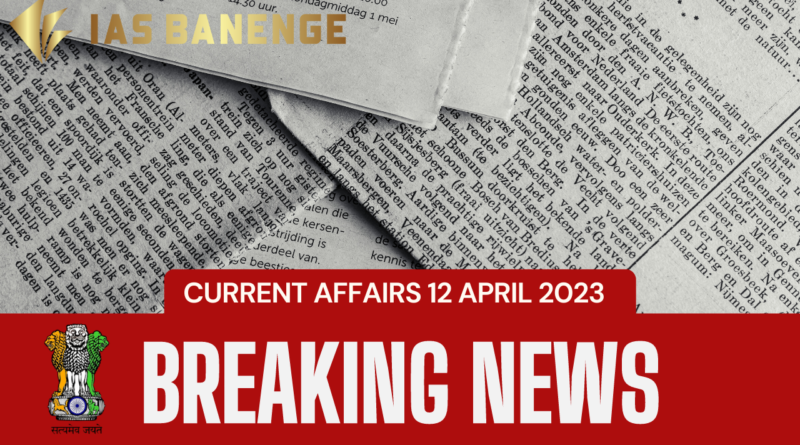Current Affairs 12 April 2023 Ias Banenge
CONTENTS
- LIGO-India Project
- Guru Tegh Bahadur
- Public Interest Immunity Claims Proceeding
- Vibrant Village Programme
- UN Democracy Fund (UNDEF)
LIGO-India Project
Context:
Recently, the government approved the construction of the Laser Interferometer Gravitational-Wave Observatory (LIGO) project after seven years of in-principle approval. It will be built by the Department of Atomic Energy and the Department of Science and Technology with the U.S. National Science Foundation and several national and international research institutions.
READ MORE – Current Affairs 11 April 2023 Ias Banenge
Relevance:
GS III: Science and Technology
Dimensions of the Article:
- Laser Interferometer Gravitational-Wave Observatory (LIGO)
- What is LIGO-India Project?
- Benefits for India
Laser Interferometer Gravitational-Wave Observatory (LIGO)
LIGO is a network of international laboratories designed to detect gravitational waves. Here are some key points about LIGO:
- LIGO is designed to measure changes in distance that are several orders of magnitude smaller than the length of a proton, due to the extremely low strength of gravitational waves.
- The first detection of gravitational waves was made by LIGO in the US in 2015, which led to a Nobel Prize in Physics in 2017. These waves were produced by the merger of two black holes, 1.3 billion years ago.
- Black hole mergers are one of the strongest sources of gravitational waves.
- Operational LIGO observatories exist in the United States (Hanford and Livingston), Italy (Virgo), and Japan (Kagra). Four comparable detectors are needed to detect gravitational waves globally.
- LIGO consists of two vacuum chambers, each 4 kilometers long and set up at right angles to each other, with mirrors at the end. The presence of a gravitational wave is confirmed by detecting a phase difference in the returning light rays caused by one chamber getting elongated while the other gets squished.
- LIGO is a groundbreaking international scientific experiment that has enabled us to observe and study the universe in new ways.
What is LIGO-India Project?
The LIGO-India project is a scientific mission that aims to detect gravitational waves from the universe. Here are some key points about this revolutionary experiment:
- The project involves two vacuum chambers, each with a length of 4 kilometers, placed perpendicularly to each other. These chambers are the most sensitive interferometers in the world.
- The scientific runs for the project are expected to begin in 2030.
- The observatory will be located in the Hingoli district of Maharashtra, about 450 km east of Mumbai.
- LIGO-India will be the fifth node of the planned network and will make India an integral part of one of the most prestigious international scientific experiments.
- The project will position India as a unique platform that brings together the frontiers of science and technology of the quantum and the cosmos.
- Apart from enabling dramatic returns in astronomy and astrophysics, the LIGO-India project would have several spin-off benefits to Indian science.
- The project is expected to leapfrog Indian science and technology in cutting-edge frontiers of great national relevance.
- The LIGO-India project is set to revolutionize the way we understand the universe and position India as a global leader in science and technology.
What are Gravitational Waves?
- Gravitational waves were first postulated (1916) in Albert Einstein’s General Theory of Relativity, which explains how gravity works.
- These waves are produced by the movement of massive celestial bodies, such as black holes or neutron stars, and are the ripples in spacetime that propagate outward.
Benefits for India:
- The project will provide scientists and engineers with unprecedented opportunity to delve further into the field of gravitational waves and to lead the world in this new astronomical frontier.
- The LIGO-India project would provide significant cutting-edge technology prospects for Indian industry, which will be involved in the construction of an eight-kilometer long beam tube at ultra-high vacuum on level ground.
- India will join the worldwide network of gravitational wave detectors once it is established.
- Establishing an observatory in India is particularly important since the longer the distance between observatories, the more accurate the detection of gravity waves will be.
Source: Indian Express
Guru Tegh Bahadur
Context:
The Parkash Purab of Sri Guru Tegh Bahadur, the ninth guru of the Sikhs, is being celebrated on April 11.
Relevance:
GS I- History
Dimensions of the Article:
- About Guru Tegh Bahadur
- Run-in with the Mughals
- The guru’s martyrdom
About Guru Tegh Bahadur:
- Tegh Bahadur was born in Amritsar on April 21, 1621 to Mata Nanki and Guru Hargobind, the sixth Sikh guru, who raised an army against the Mughals and introduced the concept of warrior saints.
- As a boy, Tegh Bahadur was called Tyag Mal because of his ascetic nature.
- He spent his early childhood in Amritsar under the tutelage of Bhai Gurdas, who taught him Gurmukhi, Hindi, Sanskrit, and Indian religious philosophy, while Baba Budha trained him in swordsmanship, archery and horse-riding.
- He was only 13 when he distinguished himself in a battle against a Mughal chieftain.
- His bravery and swordsmanship in the battle earned him the name of Tegh Bahadur.
- He was married to Mata Gujri at Kartarpur in 1632, and subsequently left for Bakala near Amritsar.
- Guru Tegh Bahadur was the ninth of ten Gurus of the Sikh religion.
The Guru’s times
- Aurangzeb was the ruling Mughal emperor at the time.
- Guru Tegh Bahadur who started travelling extensively through Malwa and Majha, first came into conflict with the authorities when he started questioning the tradition of worshipping at the graves of pirs and faqirs.
- He preached against this practice, and urged his followers to be ‘nirbhau’ (fearless) and ‘nirvair’ (without envy).
- His sermons, delivered in a mix of Sadukhri and Braj languages, were widely understood from Sindh to Bengal. The metaphors he used resonated with people across North India.
- Guru Tegh Bahadur often alluded to Panchali (Draupadi) and Ganika in his preachings and declared that Hindustan could regain its piety if it took refuge in one God.
Run-in with the Mughals
- As his message began to spread, a local chieftain at Dhamtan near Jind in present-day Haryana picked him up on fabricated charges of collecting revenue from villagers, and took him to Delhi.
- But Raja Ram Singh of Amer, whose family was a long-time follower of the gurus, intervened and kept him in his house for around two months until he convinced Aurangzeb that the guru was a holy man with no political ambitions.
- Earlier, Raja Jai Singh of Amer had donated land for a dharamshala where the gurus could rest while visiting Delhi.
- The present-day Bangla Sahib gurdwara is built on this site.
Travels beyond Punjab
- A little more than a year after setting up his headquarters in present-day Anandpur Sahib in 1665, the guru spent four-odd years travelling up to Dhaka in the east, and going up to Puri in Odisha.
- He also visited Mathura, Agra, Benares, Allahabad, and Patna, where he left his wife and her brother in the care of the local devotees. Guru Gobind Singh was born in Patna in 1666.
- While the guru was on the way back from Dhaka, Raja Ram Singh sought his help to broker a truce with the Ahom king.
- Gurdwara Dhubri Sahib on the banks of the Brahmaputra commemorates this peace accord. The guru was also honoured at Guwahati’s Kamakhya temple.
- According to historians, the guru rushed back to Punjab on learning about the increasing atrocities by the Mughals.
The guru’s martyrdom
- Aurangzeb ordered the public execution of the guru on November 11, 1675 after the guru declined to embrace Islam.
- He was tortured to death and beheaded at Chandni Chowk along with his three companions, Bhai Mati Das, who was torn asunder, Bhai Sati Das, who was burnt to death, and Bhai Dyala ji, who was put in boiling water. Till the very end they were asked to change their minds, but they remained resolute.
- In 1784, Gurdwara Sis Ganj was built on the site on which they were executed.
- Describing his father in Vichitra Natak, Guru Gobind Singh, the tenth guru who founded the Khalsa, wrote: ‘’Dharam het saka jin kiya, sees diya par sir nahin diya (He sacrificed his life for dharma, he gave up his head but not his honour).”
Source: Indian Express
Public Interest Immunity Claims Proceeding
Context:
Recently, the Supreme Court of India ruled on the use of sealed cover proceedings in courts and the telecast ban of a Malayalam channel. The Court criticised the government for silencing voices in the media and reducing constitutional rights and procedural guarantees of a fair hearing. The Court also devised an alternative procedure for Public Interest Immunity claims proceedings to replace the use of sealed covers.
Relevance:
GS II: Indian Polity
Dimensions of the Article
- What is sealed cover Proceedings?
- Public Interest Immunity Claims Proceeding
What is sealed cover Proceedings?
- It is a practice used by the Supreme Court and sometimes lower courts, of asking for or accepting information from government agencies in sealed envelopes that can only be accessed by judges.
- While a specific law does not define the doctrine of sealed cover, the Supreme Court derives its power to use it from Rule 7 of order XIII of the Supreme Court Rules and Section 123 of the Indian Evidence Act of 1872.
- It is stated under the said rule that if the Chief Justice or court directs certain information to be kept under sealed cover or considers it of confidential nature, no party would be allowed access to the contents of such information, except if the Chief Justice himself orders that the opposite party be allowed to access it.
It also mentions that information can be kept confidential if its
- Publication is not considered to be in the interest of the public.
- As for the Evidence Act, official unpublished documents relating to state affairs are protected and a public officer cannot be compelled to disclose such documents.
- Other instances where information may be sought in secrecy or confidence is when its publication impedes an ongoing investigation, such as details which are part of the police’s case diary; or breaches the privacy of an individual.
Public Interest Immunity Claims Proceeding
- Supreme Court’s Alternative to Sealed Cover Proceedings: The Supreme Court developed Public Interest Immunity (PII) claims proceedings as an “alternative” to sealed cover proceedings for state requests for confidentiality.
PII Procedure – Role of Amicus Curiae:
- The court appoints an amicus curiae to act as a bridge between the parties involved in public interest immunity claims. The amicus curiae will have access to the materials sought to be withheld by the state and allowed to interact with the applicant and their lawyer before the proceedings to ascertain their case.
- The amicus curiae shall represent the interests of the applicant and be bound by oath to not disclose or discuss the material with any other person.
Drawback of PII Proceedings:
- PII claims proceedings take place in a closed setting, which might fall against the constitutional mandate requiring all judgments of the Supreme Court to be delivered in open court.
Supreme Court’s Response:
- The Supreme Court stated that a reasoned order allowing or dismissing the PII claim of the state should be pronounced in open court, despite PII proceedings taking place in a closed setting.
- PII claims also impact the principles of natural justice, but sealed cover proceedings infringe on both the principles of natural justice and open justice.
Source: Indian Express
Vibrant Village Programme
Context:
Recently, Union home Minister launches vibrant villages program on China border in Arunachal Pradesh.
Relevance:
GS III- Indian Economy (Infrastructure)
Dimensions of the Article:
- About Vibrant Village Programme
- Need of such scheme
About Vibrant Village Programme
- The program’s goal is to enhance infrastructure in villages along India’s China border.
- In states like Uttarakhand, Himachal Pradesh, and Arunachal Pradesh, infrastructure will be enhanced.
- Residential and tourism centres will be built as part of the programme.
- It will also facilitate the development of decentralised renewable energy sources and increase road connectivity.
- Aside from that, there will be direct access to Doordarshan and educational channels. A source of income will be offered.
Focus areas
- It emphasises the generation of livelihoods, road connectivity, housing, rural infrastructure, renewable energy, television, and broadband connections.
- This goal will be achieved by improving infrastructure in villages near the Line of Actual Control (LAC).
Need of such scheme:
- The programme is a rebuke to China’s model villages, but the term was picked with care to avoid causing a stir in the neighbouring country.
- In recent years, China has created new communities along the LAC, mainly across the Arunachal Pradesh border.
- Villages on the Indian side of the border have undergone unprecedented out-migration while China has been placing new citizens in border areas.
UN Democracy Fund (UNDEF)
Context:
India is the fourth highest donor to UN Democracy Fund, which funds at least 68 projects worldwide linked to the Open Society Foundation.
Relevance:
GS II: International Relations
What is the UN Democracy Fund?
- Establishment and Objectives: The UN Democracy Fund (UNDEF) was established by former UN Secretary-General Kofi Annan in 2005 as a United Nations General Trust Fund. Its primary objective is to support democratization efforts worldwide by empowering civil society, promoting human rights, and encouraging the participation of all groups in democratic processes.
- Membership and Funding: India is a founding member of UNDEF. The Fund is entirely financed by voluntary contributions from governments.
- Advisory Board: The UNDEF Advisory Board is constituted by the Secretary-General and comprises of three categories of members:
- UN Member States who have made the largest cumulative financial contributions to the Fund over the previous three years.
- International civil society organizations.
- Individuals serving in a personal capacity.
- The Advisory Board provides advice and guidance on UNDEF strategy, programme areas, and project proposals.
Source: Indian Express




